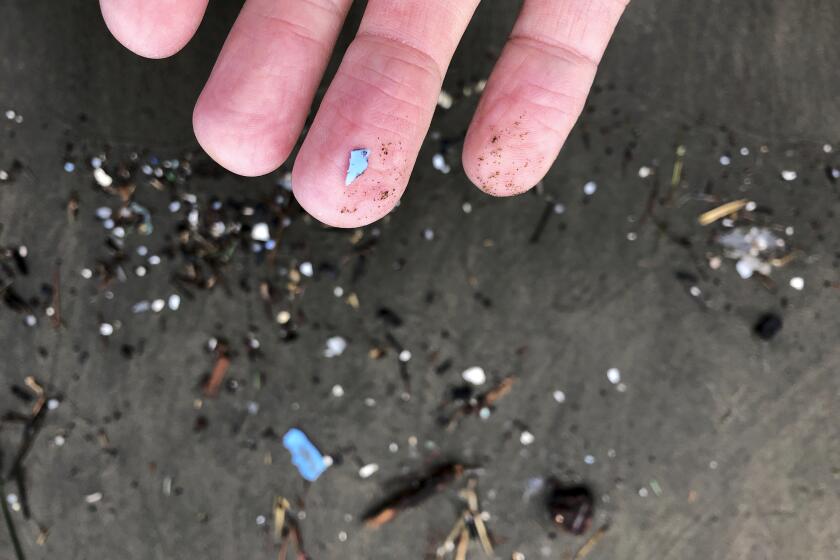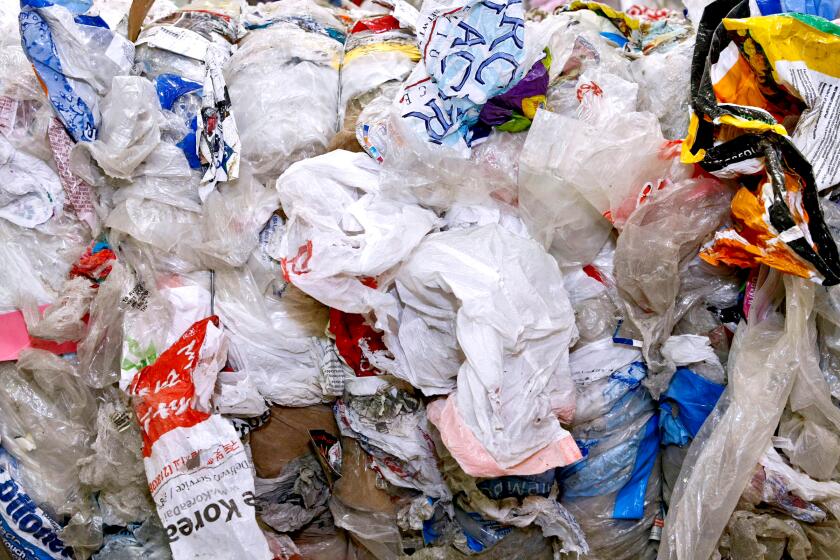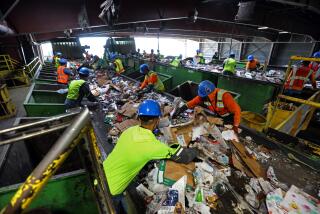
- Share via
Researchers have located one more anatomical organ where microplastics — of all shapes and constituents — are found: human testes.
And although they can’t say for sure, they suspect the presence of these jagged bits and strands of polymers such as polyethylene, polyvinyl chloride and polystyrene could be — in part — behind a global trend in diminishing sperm quality and quantity.
Aggressive and impactful reporting on climate change, the environment, health and science.
In 2022, a team of researchers published a paper showing that global sperm counts fell about 1.2% per year between 1973 and 2018. From the year 2000, that rate accelerated to more than 2.6% per year.
“What I think will grab people’s attention with this study is the fact that plastic is in the testicles and potentially contributing to disarray in the function of the testicles,” said Leonardo Trasande, a pediatrician and public policy expert at New York University’s Grossman School of Medicine and Wagner School of Public Service.
“What should have gotten people excited all along is the fact that we’ve known that the invisible chemicals — the phthalates, the bisphenols and the PFAS that are used in plastic materials — are already known to be problems,” he said. “And so if this is what it takes to get people’s attention, I’m a bit sad. Because we already had enough evidence that plastics were bad for testicular function.”
Others, including Philip Landrigan, director of the Program for Global Public Health and the Common Good at Boston College, said the study was “consistent with a whole series of papers that have come out now in the last few years” showing these particles in a variety of organs, including the heart, liver, lungs and brain.
“It’s no surprise that microplastics are in the testes. The plastic is ubiquitous in today’s world, the stuff breaks down, and the smaller the particle, the more easily it can move into and throughout the human body,” he said.
Xiaozhong Yu, a professor of environmental health at the University of New Mexico — and an author on this latest research — said he’d been researching the effects of different chemicals on sperm production for years, and it was only recently that a colleague suggested he look for microplastics in testes.
“I said, ‘Are you joking?’,” he said, recalling the conversation, explaining he was pretty certain he wouldn’t find microplastics in testes because — like the brain — these sperm-generating factories are insulated by a protective barrier.
Microplastics draw scrutiny as potential risk factor for cardiovascular disease.
Nevertheless, they gave it a go.
They started by trying it out in dog testes. They were able to acquire 47 from neutering clinics. (The pet owners all provided permission.)
They found microplastics in small dogs, big dogs, young dogs and old dogs. The plastic bits were in every dog testis they examined. The number ranged from 2.36 micrograms per gram to 485.77 micrograms per gram. The average was 122.63 micrograms per gram, and 12 polymers were identified. The most abundant were polyethylene — the material found in plastic packaging, films and bottles — and polyvinyl chloride — a material found in most household water pipes.
He said he immediately went back to investigate their quality control. Maybe the testes had become contaminated at some point during the procedure or testing?
He and his team were able to rule that out, although Landrigan noted that contamination was still possible — unless everything, from procurement to analysis had been done in a “clean” room devoid of all plastic.
Ten years after California passed landmark legislation to reduce plastic bag use, the tonnage of discarded bags has skyrocketed. What happened?
Yu and his team then decided to look at human samples. In the end, they were able to examine 23 testes from men ages 16 to 88. The tissue was acquired from males who had died in accidents and whose testes had been preserved post-autopsy. He said all samples were from men who had died in 2016 — made available following a seven-year storage requirement, after which time such samples are usually discarded.
Once again, they found microplastics in every sample they examined, and as with the dog testes, there was wide variation — from 161.22 micrograms per gram to 695.94 micrograms per gram, with an average of 328.44 micrograms per gram — nearly three times greater than what they found in dogs.
The microplastics in human testes were also composed of a variety of polymers, with polyethylene being the most common, followed by ABS (acrylonitrile, butadiene and styrene monomers — which is used to make a variety of products, including toys, automotive parts, medical equipment and consumer electronics), N66 (a kind of nylon), polyvinyl chloride and others.
The researchers also noted a correlation between the concentrations of PVC and polyethylene and testes weight: The higher the concentration, the lower the weight.
“Generally, a decreased testis weight is indicative of reduced spermatogenesis,” wrote the authors in the paper.
Yu said the difference in humans and dogs between polymer types — with dogs showing higher concentrations of PVC than men — likely has to do with lifestyle differences. He said consumer trends show a general aversion to eating or drinking out of bottles and foodware made from PVC, which contains bisphenol A — an additive that has been associated with health and developmental harm.
However, he began looking at dog toys, and noticed many of them are made from this kind of plastic.
“People are choosing to avoid it,” he said. But the market hasn’t budged in the same way for dogs.
Asked what the major route of exposure was for dogs and people, he said “microplastics are everywhere — in the air, in the drinking water, in the food, in our clothes. We don’t exactly know what is the most probable route. But they are everywhere.”
California winds spread microplastics from natural fertilizers at higher concentrations than previously known, a team of UCLA researchers has found.
He also noticed variation within the groups. Dog testes acquired from public veterinary clinics showed higher levels of microplastics than those from private clinics, “potentially reflecting the influence of socioeconomic differences on the living environments and lifestyles of dogs.”
The researchers were also not able to find a correlation between age and microplastic concentration — a finding that surprised them. (Although men over the age of 55 had the least amount).
“The absence of a distinct age-dependent accumulation of microplastics in human testes may be due to unique physiological and biological processes of spermatogenesis,” they wrote, noting the continual renewal and release of sperm, which could “help mitigate the buildup of microplastics over time.”
That hypothesis, they noted, was supported by the presence of microplastics in human seminal fluid.
“The reality is that the petrochemical industry has gotten a pass all these years,” said Trasande, the NYU professor. “We know that plastics come from the petrochemical industry ... and it’s no secret that we have paid as a society by letting the petrochemical industry pollute us. Now we’re paying the consequences. And if we don’t reverse course fairly quickly, we will have an even bigger problems before us because plastic consumption is growing, not slowing down.”
Zero-waste refill stations want you to rethink what a trip to the store looks like. Here’s a list of places to buy soap, shampoo, laundry pods and more.
Landrigan agreed and noted that nations were currently in negotiations to sign a treaty that would curb the use of plastic and cap production.
“Plastic production is increasing exponentially,” he said noting that it’s increased more than 200-fold since the 1950s. He said plastic production is on a trajectory to double by 2040 and triple by 2060. There have been a total of about 8 billion tons of plastic produced since 1950, he said, and about 6 billion tons is “floating around us, most of it in the form of microplastics.”
He said the anatomical location of this latest microplastic discovery may hit close to home for lawmakers, who until this time, have not been too concerned.
He said he’d had to testify in the Senate several years ago about endocrine disruptors, and mentioned that sperm quantity was reduced in men who’d been exposed.
“Two senators sat back and unconsciously crossed their legs,” he said. “The body language was amazing.”













